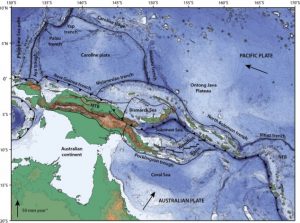
JCU’s Dr Rob Holm applied modern technology to existing geological data. He said the results open up completely new and original interpretations of geological processes.
“This research shows the value of applying new techniques to the extensive database of already existing scientific literature,” he said.
“It can track the motion of tectonic plates to explain the formation of oceans and mountain ranges as these plates break apart and crash into one another, and even holds far-reaching implications for the distribution of animal species and Earth’s climate though time.”
The animation shows the recent (from less than 8 million years ago) geological history of Papua New Guinea and the Solomon Islands. “Geologists can now see the different processes that are active in tectonic plates and mountain building in almost real time,” said Dr Holm.
He said it had revealed different geological relationships for the region, which had not been previously considered.
“This work highlights how the motion of tectonic plates and their related landmasses are intricately linked to the motion of other plates and plate boundaries surrounding them, and those further afield,” he said.
Dr Holm, a lecturer in petrology and mineralogy, said the work had more than theoretical applications. “We can now see the geological settings during the formation of mineral deposits rather than simply at the present day. As a result we gain a better understanding of the geological settings for deposit formation and can better predict worthwhile locations to explore.”
He said the work could also help with understanding and predicting earthquakes or volcanic eruptions. “It allows us to reconstruct and track the boundaries between tectonic plates. A better appreciation of this will give us a greater ability to predict where and when these hazards can occur.”
Dr Holm said the research illustrated the highly dynamic setting of the PNG and Solomon Islands region.
“Over a short geological time the Bismarck Sea has been created where no ocean previously existed, and the Solomon Sea has been reduced to a few 100 km across from what was once a vast ocean basin in excess of 1000 km wide, ” he said.
Dr Holm said the research will be expanded throughout the region to understand the evolution of the southwest Pacific, and also to investigate the long-term geological development of the region.
Reference:
Robert J. Holm, Gideon Rosenbaum, Simon W. Richards. Post 8Ma reconstruction of Papua New Guinea and Solomon Islands: Microplate tectonics in a convergent plate boundary setting. Earth-Science Reviews, 2016; 156: 66 DOI: 10.1016/j.earscirev.2016.03.005
Note: The above post is reprinted from materials provided by James Cook University.










